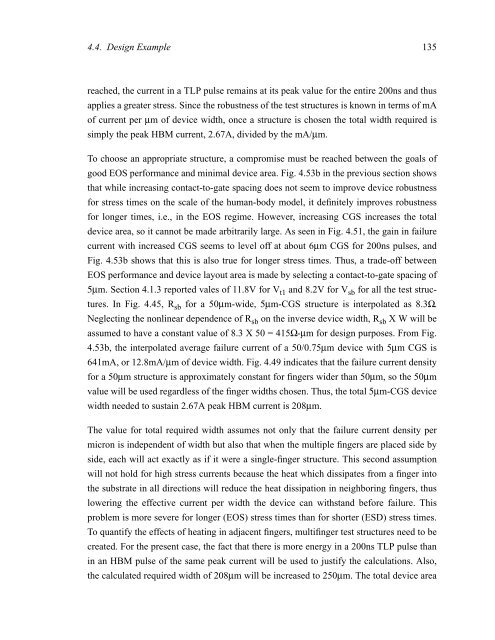characterization, modeling, and design of esd protection circuits
characterization, modeling, and design of esd protection circuits
characterization, modeling, and design of esd protection circuits
Create successful ePaper yourself
Turn your PDF publications into a flip-book with our unique Google optimized e-Paper software.
4.4. Design Example 135<br />
reached, the current in a TLP pulse remains at its peak value for the entire 200ns <strong>and</strong> thus<br />
applies a greater stress. Since the robustness <strong>of</strong> the test structures is known in terms <strong>of</strong> mA<br />
<strong>of</strong> current per µm <strong>of</strong> device width, once a structure is chosen the total width required is<br />
simply the peak HBM current, 2.67A, divided by the mA/µm.<br />
To choose an appropriate structure, a compromise must be reached between the goals <strong>of</strong><br />
good EOS performance <strong>and</strong> minimal device area. Fig. 4.53b in the previous section shows<br />
that while increasing contact-to-gate spacing does not seem to improve device robustness<br />
for stress times on the scale <strong>of</strong> the human-body model, it definitely improves robustness<br />
for longer times, i.e., in the EOS regime. However, increasing CGS increases the total<br />
device area, so it cannot be made arbitrarily large. As seen in Fig. 4.51, the gain in failure<br />
current with increased CGS seems to level <strong>of</strong>f at about 6µm CGS for 200ns pulses, <strong>and</strong><br />
Fig. 4.53b shows that this is also true for longer stress times. Thus, a trade-<strong>of</strong>f between<br />
EOS performance <strong>and</strong> device layout area is made by selecting a contact-to-gate spacing <strong>of</strong><br />
5µm. Section 4.1.3 reported vales <strong>of</strong> 11.8V for Vt1 <strong>and</strong> 8.2V for Vsb for all the test structures.<br />
In Fig. 4.45, Rsb for a 50µm-wide, 5µm-CGS structure is interpolated as 8.3Ω.<br />
Neglecting the nonlinear dependence <strong>of</strong> Rsb on the inverse device width, Rsb X W will be<br />
assumed to have a constant value <strong>of</strong> 8.3 X 50 = 415Ω-µm for <strong>design</strong> purposes. From Fig.<br />
4.53b, the interpolated average failure current <strong>of</strong> a 50/0.75µm device with 5µm CGS is<br />
641mA, or 12.8mA/µm <strong>of</strong> device width. Fig. 4.49 indicates that the failure current density<br />
for a 50µm structure is approximately constant for fingers wider than 50µm, so the 50µm<br />
value will be used regardless <strong>of</strong> the finger widths chosen. Thus, the total 5µm-CGS device<br />
width needed to sustain 2.67A peak HBM current is 208µm.<br />
The value for total required width assumes not only that the failure current density per<br />
micron is independent <strong>of</strong> width but also that when the multiple fingers are placed side by<br />
side, each will act exactly as if it were a single-finger structure. This second assumption<br />
will not hold for high stress currents because the heat which dissipates from a finger into<br />
the substrate in all directions will reduce the heat dissipation in neighboring fingers, thus<br />
lowering the effective current per width the device can withst<strong>and</strong> before failure. This<br />
problem is more severe for longer (EOS) stress times than for shorter (ESD) stress times.<br />
To quantify the effects <strong>of</strong> heating in adjacent fingers, multifinger test structures need to be<br />
created. For the present case, the fact that there is more energy in a 200ns TLP pulse than<br />
in an HBM pulse <strong>of</strong> the same peak current will be used to justify the calculations. Also,<br />
the calculated required width <strong>of</strong> 208µm will be increased to 250µm. The total device area
















